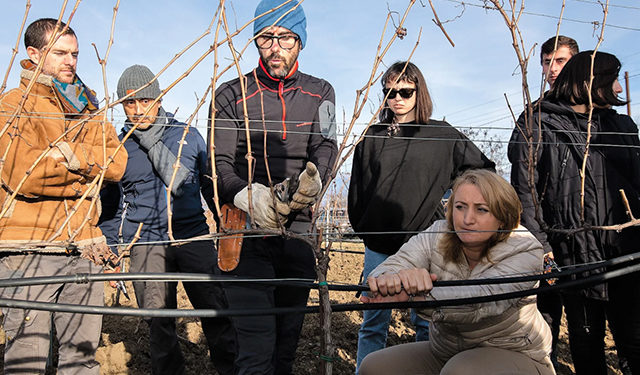Twenty grapevine producers participated in training held at several locations in Kakheti, a traditional winemaking region of Georgia, in January. International expert Julio Prieto, specialized in phytosanitary problems of grapevines, from the Ministry of Agriculture of Spain, conducted the trainings with the support of the European Union and FAO in the framework of the EU4Business program.
EU Innovative Action for Private Sector Competitiveness in Georgia is a joint initiative of the European Union and four UN Agencies, which was launched in 2019 with a budget of EUR 5 million. The project aims to enhance entrepreneurship and business sophistication by strengthening the capacities of government and local entities to develop and operate clusters, and supporting companies directly with strategic investments and better connections with diaspora group, while also demonstrating the effectiveness of these strategies to businesses.
During the trainings, Mr. Prieto covered the entire vineyard cultivation process and the complete cycle of grapevine production, from growing saplings to harvesting grapes. The learning sessions included such topics as general management of various types of vineyards, planning of pruning, fertilization, as well as irrigation, organic grapevine production and Integrated Pest Management.
The issue of pest management was the most interesting for all winegrowers present, as the pest “Lobesia botrana,” also known as the “European grape worm,” is a common problem. The expert specifically focused on biological pest control through means of mating disruption pheromones. This method has already been tested in the region, with poor results due to the lack of technical guidance.
The EU and FAO stay committed to supporting agricultural wine producers in Georgia to make the agriculture sector more competitive, profitable and more resilient to new challenges
“It was very interesting to hear about the Spanish and international experience in addressing the challenges of vine worms. These training sessions were very informative, even the most experienced winegrowers learned a lot, and for the newcomers, it provided crucial knowledge to avoid many problems,” Giorgi Rukhadze, owner of George Grey Winery, who participated in the training, stated.
“We acknowledge the great importance of grapevines for Georgia, both economically and traditionally,” said Javier Sanz Alvarez, EU-FAO Program Coordinator. “The EU and FAO stay committed to supporting agricultural wine producers in Georgia to make the agriculture sector more competitive, profitable and more resilient to new challenges.”
Georgia Exports 107 mln Bottles of Wine in 2021
Revenue from wine exported from Georgia last year was equal to $250 million. According to the National Wine Agency, wine exports in 2021 were 359% higher than in 2012.
In 2012, only 23 million bottles of wine were exported from Georgia, and the income received from exports amounted to $71 million, while in 2021, the income received from 107 million bottles of wine exported from Georgia was equal to $250 million.
In 2021, both the amount of exported wine and export earnings increased by 16% compared to 2020. In addition to wine, in 2021, 42.2 million bottles of brandy were exported from Georgia to many countries around the world, which is 30% more than in 2020 and 554% more than in 2012 (when only 6 million bottles were exported).
According to the agency, the brandy export earnings reached $78.3 million (up 19%). In 2012, brandy exports earned $20 million.
In 2021, 1 million bottles (0.5 l) of chacha were exported; the increase in exports compared to 2020 was 145%, while the increase compared to 2012 was 622% (in 2012, 145 thousand bottles of chacha were exported). Revenue from chacha exports in 2021 reached $2.6 million. The growth was 126% compared to the same period last year. In 2012, the income from the export of chacha was $584,000 US dollars.
Export growth dynamics are maintained in strategic markets: Poland 34% (7, 003, 031), China 29% (5, 934, 937), US 19% (1, 084, 278), Germany 28% (892, 348), Latvia 19% (1, 900, 519) , Lithuania 45% (986, 740), Japan 12% (197, 638) and the UK 71% (736, 391). The largest volume of wine – 62, 115,759 bottles – was exported to Russia.
It is noteworthy that for the first time in the history of independent Georgia, Georgian wine exports to the United States exceeded 1 million bottles.
“441 companies exported different volumes of wine from Georgia, while in 2012, only 120 companies had the opportunity to export wine,” the agency said in a statement.
They also noted that exports of wine, brandy and chacha earned up to $400 million, which is 18% more than in the same period in 2020 and 142% more than in 2012, which amounted to $163 million.
January Sales Look Promising for the Year Ahead
Georgia exported 5.3 million bottles of wine to 35 countries in January 2022, 51% more compared to the same period last year, the Ministry of Agriculture and Environmental Protection announced.
Based on the same source, the exports generated $11.6 million from the sale of wine abroad in January, marking an increase of 43%.
“Dynamics of export growth are maintained in strategic markets, where in order to promote and increase awareness of Georgian wine, the National Wine Agency implements marketing measures: Poland 103%, China 514%, Lithuania 114%, USA 245%, Latvia 22%, Estonia 102%, Japan 482%, and the United Kingdom 35%.
“Growth is also noticeable in the following countries: Ukraine 93%, Kazakhstan 106%, the Netherlands 74%, Sweden 234%, Russia 34%, Mongolia 23%, etc.
“12,123 companies exported different amounts of wine from Georgia,” reported the state agency.
By Katie Ruth Davies, Ana Dumbadze














